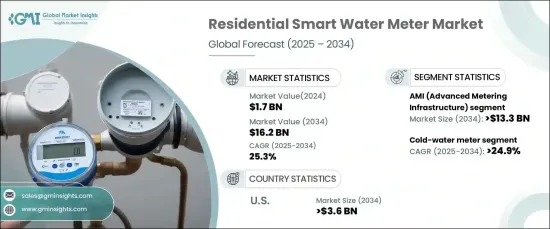
세계의 주택용 스마트 수도 미터 시장은 2024년에 17억 달러로 평가되며, 2025-2034년에 25.3%라는 경이로운 CAGR로 확대할 것으로 예측됩니다.
이러한 성장의 주요 요인은 물 절약에 대한 관심 증가, 지속적인 기술 혁신, 다양한 정부 지원 구상에 기인합니다. 효율적인 물 관리에 대한 전 세계적인 수요가 증가함에 따라 스마트 수도 계량기는 일반 가정과 유틸리티 사업자에게 필수적인 툴이 되고 있습니다. 이 첨단 장비는 물 사용량을 실시간으로 모니터링하고, 소비자가 누수를 감지하고, 낭비를 줄이며, 소비를 최적화할 수 있도록 도와주는 역할을 합니다. 전 세계에서 물 부족에 대한 우려가 높아짐에 따라 자원 관리에 대한 보다 지속가능하고 스마트한 접근 방식의 필요성이 증가하고 있습니다. 이에 대응하기 위해 지자체와 공기업은 스마트 계량기 시스템에 많은 투자를 하고 있습니다. 또한 사물인터넷(IoT)과 데이터 분석을 이러한 계량기에 통합하여 강력하고 사용하기 쉬운 플랫폼으로 변모하고 있습니다. 이러한 시스템은 실용적인 인사이트을 제공하여 주택 소유자와 수도 사업자가 정보에 입각한 의사결정을 내리고 자원 효율성을 개선하는 데 도움을 주고 있습니다.

이 시장의 주요 기업인 AMI(Advanced Metering Infrastructure) 부문은 2034년까지 133억 달러 규모에 달할 것으로 예상되며, AMI의 매력은 뛰어난 정확도로 실시간 데이터를 제공하고 유틸리티와 소비자 간의 양방향 통신을 가능하게 하는 능력에 있습니다. 수도 사업자는 원격지에서 사용량을 추적하고, 누수를 감지하고, 청구 프로세스를 간소화할 수 있으며, 이 모든 것이 무매출 물의 손실을 최소화하면서 운영 효율성을 높이는 데 도움이 됩니다. 많은 장점을 가진 AMI는 특히 자원 절약과 운영 최적화가 가장 중요한 지역에서 현대적 물 관리 시스템의 중추로 점점 더 많은 관심을 받고 있습니다.
| 시장 범위 | |
|---|---|
| 시작연도 | 2024년 |
| 예측연도 | 2025-2034년 |
| 시작 금액 | 17억 달러 |
| 예상 금액 | 162억 달러 |
| CAGR | 25.3% |
시장 성장은 주거용 스마트 수도 미터 수요에 크게 영향을 받을 것으로 예상되며, 2034년까지 24.9%의 연평균 복합 성장률(CAGR)을 나타낼 것으로 예상되며, 특히 식수 소비량을 추적하는 데 필수적인 냉수 계량기의 경우, 이러한 계량기가 널리 채택될 것으로 예상됩니다. 냉수 계량기는 소비자와 유틸리티 사업자가 수자원을 효과적으로 관리할 수 있도록 도와주기 때문에 사용이 급증하고 있습니다. 규제 압력과 IoT 및 AMI 개발을 포함한 기술 발전은 이러한 계량기를 더욱 정확하고 사용하기 쉽게 만들어 그 매력을 더욱 높이고 있습니다.
미국에서는 2034년까지 주거용 스마트 수도 미터 시장 규모가 36억 달러에 달할 것으로 예상됩니다. 이는 지속가능성에 대한 인식 증가, 특히 가뭄에 취약한 지역의 물 부족을 해결하기 위한 긴급한 필요성과 물 인프라의 현대화가 주요 원인으로 작용하고 있습니다. 주 및 연방 정부의 규제가 보다 지속가능한 물 사용을 촉진하는 가운데, 미국 전역의 유틸리티 회사들은 물 소비를 보다 효과적으로 모니터링하고 관리하기 위해 스마트 계량기 솔루션을 도입하고 있습니다. 첨단 기술과 강력한 정책적 지원이 결합되면서 미국 시장은 향후 10년간 괄목할 만한 성장을 이룰 것으로 예상됩니다.
The Global Residential Smart Water Meter Market, valued at USD 1.7 billion in 2024, is projected to expand at a staggering CAGR of 25.3% between 2025 and 2034. This growth is largely fueled by increasing concerns about water conservation, ongoing technological innovations, and a host of government-backed initiatives. As the global demand for efficient water management grows, smart water meters are becoming indispensable tools for households and utilities alike. These advanced devices enable real-time monitoring of water usage, empowering consumers to detect leaks, reduce wastage, and optimize consumption. Given the escalating concerns about water scarcity worldwide, there is a growing need for more sustainable and smarter approaches to resource management. In response, municipalities and utilities are investing heavily in smart metering systems. Moreover, the integration of the Internet of Things (IoT) and data analytics into these meters is transforming them into powerful, user-friendly platforms. These systems offer actionable insights, helping homeowners and water service providers make informed decisions and improve resource efficiency.

The Advanced Metering Infrastructure (AMI) segment, which is a key player in this market, is expected to reach USD 13.3 billion by 2034. The appeal of AMI lies in its ability to deliver real-time data with remarkable accuracy and offer two-way communication between utilities and consumers. AMI technology allows water service providers to remotely track usage, detect leaks, and streamline billing processes, all of which help boost operational efficiency while minimizing non-revenue water losses. With its many benefits, AMI is increasingly seen as the backbone of modern water management systems, especially in areas where resource conservation and operational optimization are paramount.
| Market Scope | |
|---|---|
| Start Year | 2024 |
| Forecast Year | 2025-2034 |
| Start Value | $1.7 Billion |
| Forecast Value | $16.2 Billion |
| CAGR | 25.3% |
The market's growth is also heavily influenced by the demand for smart water meters in residential sectors. With a CAGR of 24.9% through 2034, these meters are expected to gain widespread adoption, particularly in the case of cold-water meters, which are vital for tracking potable water consumption. Cold-water meters are seeing a surge in use, driven by their ability to help consumers and utilities manage water resources effectively. Regulatory pressures and technological advancements, including developments in IoT and AMI, are making these meters more accurate and user-friendly, further enhancing their appeal.
In the United States, the residential smart water meter market is projected to generate USD 3.6 billion by 2034. This is largely attributed to heightened awareness of sustainability, the urgent need to address water shortages, especially in drought-prone regions, and the modernization of water infrastructure. With state and federal regulations pushing for more sustainable water usage, utilities across the U.S. are adopting smart metering solutions to monitor and manage water consumption more effectively. By combining cutting-edge technology with strong policy support, the U.S. market is set for impressive growth in the coming decade.